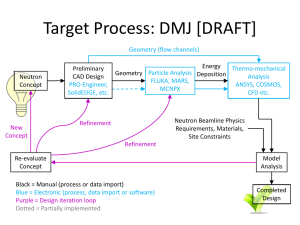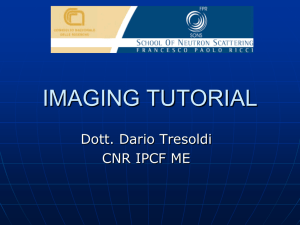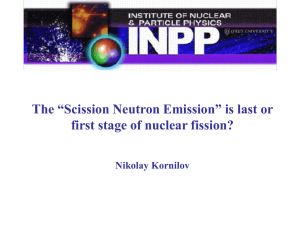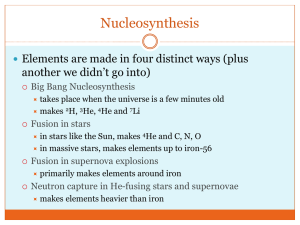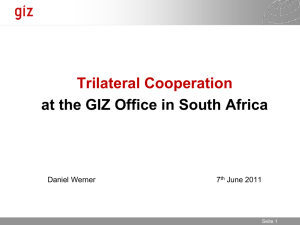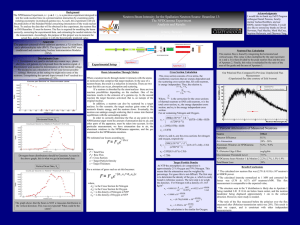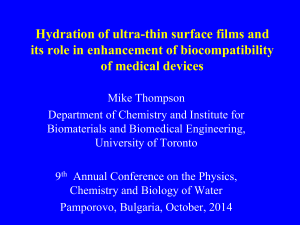Lecture_1
advertisement
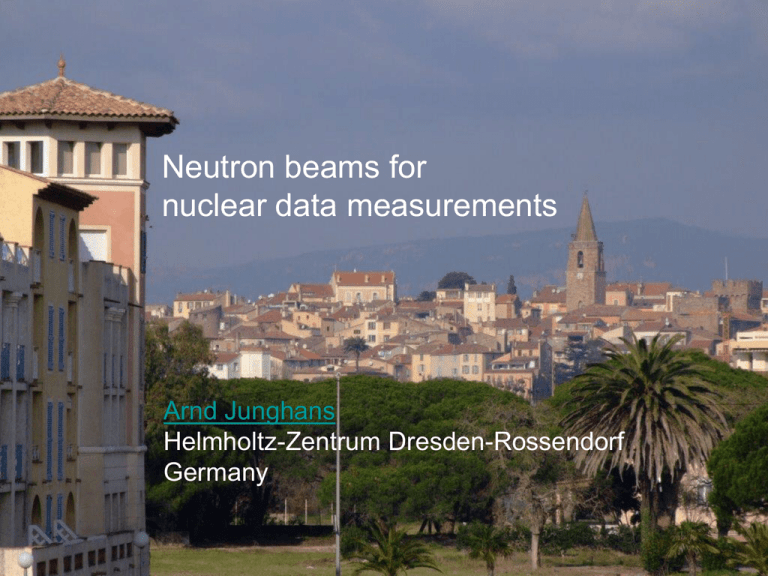
Neutron beams for nuclear data measurements Arnd Junghans Helmholtz-Zentrum Dresden-Rossendorf Germany Seite 1 Table of Content • Introduction of the speaker • • • • • Neutron sources (Terrestrial and radioisotope sources) Neutron producing nuclear reactions: Monoenergetic neutrons Kinematics e.g. 7Li(p,n)7Be Neutron reference fields: „Big Four“ reactions for neutron production Neutron generators: D(d,n)3He, T(d,n)4He reactions • • • • Time-of-flight method and neutron sources Spallation neutron sources using light-ion accelerators Slowing down of neutrons to produce eV-keV neutrons Photoneutron sources using electron accelerators Seite 2 curriculum vitae Arnd Rudolf Junghans • • • • • 1987-1994 Student of Physics at Technische Hochschule Darmstadt Diploma thesis „Influence of fission on the fragmentation of relativistic projectiles in peripheral collisions“ 1994-1997 PhD Student Technische Universität Darmstadt Dissertation „Investigation of the collectivity of nuclear excitations in the fragmentation of relativistic uranium projectiles“ 1998 Postdoc GSI Darmstadt „Studies of production methods of exotic nuclei“ 1999-2002 Postdoc + Research Assistant Professor, CENPA, University of Washington, Seattle: 7Be(p,)8B S-factor measurements -> Solar neutrino problem since 2003 Scientific Staff at Helmholtz-Zentrum Dresden-Rossendorf Group leader „Physics of Transmutation“ Development of a photoneutron source at the superconducting electron acelerator ELBE Seite 3 Doktorgesang 1994 (This is twenty years ago) Seite 4 CHARMS evening (this is 11 years ago) Seite 5 Neutron sources Neutron sources in nature: Neutrons can be formed in nuclear reactions of high-energetic cosmic particles in the upper atmosphere. The flux is inverserly proportional to the solar activity (high solar activity deformes the earth‘s magnetic field) and strongly dependend on the geographical latitude and altitude. Gordon et. al. IEEE TNS 51 (2006) 3427 • Evaporation peak Thermal peak G. Heusser, Low-radioactivity background techniques Seite 6 High energy peak Resonances from N,O due to MCNP sim. Setup: Extended range Bonner spheres 14 different size PE moderators with 3He proportional counters Neutron sources Terrestrial sources: Fission neutrons from spontaneous fission of heavy nuclei Spontaneous fission has been observed on thorium and uranium (and heavier actinides that are not primordial) nuclide f (a-1) 235U 1.98*10-18 238U 7.03*10-17 232Th <6.9*10-22 Artificial neutron sources: 1. Radioisotope sources based on (,n) reactions, e.g. (Po,Be), (Am,Be) (Cm,13C) or spontaneous fission, e.g. 252Cf (sf) 2. Photoneutron sources 2H(,n)H, 9Be(,n) 3. Accelerator based sources, e.g. (d,n) (p,n) reactions on light nuclei 4. Nuclear reactors (fission neutrons + moderation) 5. Spallation neutron sources Seite 7 Radioisotope sources • • • • • • Seite 8 (,n) reactions on light nuclei with positive Q-value: e.g. Be, B 9Be(,n)12C Q=5.71 MeV, E = 0 .. 13 MeV n -emitter mixed with Be-powder complicated neutron energy spectrum, neutron intensity also dependent on purity of the -emitter background from high-energy gamma emission 13C(,n) is also the main source of neutrons in the astrophyiscal s-process -delayed neutron emission. e.g. 87Br (t 87Kr* + - 87Kr* 86Kr + n 1/2 = 55.7 s) not a practicable neutron source but important for reactor criticality control Neutron source: 241Am: 9Be(,n)12C typically: 5 g Be 0.37 g 241AmO2 = 1 Ci Content: Mixture of -Emitter M and Beryllium as a fine powder or as alloy or Actinide-Boride Yield ca. 10-4 n/-decay (Most -particles are stopped without causing a nuclear reaction.) Lorch, Int. Jour. Appl. Rad. Iso. 24 (1973) 585 Seite 9 complex neutron spectrum : depending on the individual source. Neutron source: 241Am: 9Be(,n)12C Transitions to discrete states from CN decay 13C* 12C* Proton recoils in stilbene neutron spectrum from a thin target shows these transitions scintillators e.g.transition to the 4.44 MeV state in 12C: En = E + Q – E*(12C) – Erecoil(12C) = 7.78 MeV + 5.7 MeV – 4.44 MeV – 0.588 MeV = 8.453 MeV INDC-NDS-0114(1980) Seite 10 Am-Be source spectrum Non g.s. neutron groups also lead to high energy -ray emission Seite 11 252Cf spontaneous fission neutron spectrum dN E 1/ 2 e E / T dE T1/2 = 2.65 a, = 96.908%, SF 3.092% <n> = 3.756 +- 0.005; 0.116 n/Bq; 2.30*106 n/(s g) Fission neutron spectrum has a approximately maxwellian distribution with T = 1.42 MeV 252Cf is a very strong radioisotope neutron source Also emitted are 10 prompt -rays per fission. 252Cf Seite 12 Photoneutron sources with radioisotopes • • 2H(,n)H, • • • m – neutron mass, M residual nucleus mass monoenergetic -emitter can deliver a quasimonoenergetic neutron source dependence of En on emission angle • • low neutron yield ca. 10-5 – 10-6 n/ high energetic -emitters are mostly short lived production in reactor or accelerator facility, e.g. 24Na t1/2 = 15 h, 88Y t1/2 = 107 d Seite 13 Q= -2.226 MeV 9Be(,n) Q = -1.666 MeV negative Q-value high energetic -emitter is required Neutron producing nuclear reactions • • • • In two-body reactions monoenergetic neutrons can be produced, e.g. DT-reaction: 3H(2H,n)4He, Q = 17.16 MeV Kinematics determines the angular distribution and energy spectrum The yield (neutrons /primary particles) is determined by the 𝑑𝜎 differential cross section 𝑑Ω (𝐸𝑝 , Θ) Realistic yield determination by integration over the target thickness and angular range (slowing down of the beam in the target material) 𝑛𝑡𝑎𝑟 𝑑𝑁𝑛 Θ 𝑁𝑝 Seite 14 Relativistic two body kinematics • • • 𝑚1 𝑚2 , 𝑚3 𝑚4 projectile 𝑚2 hits target 𝑚1 after the reaction: ejectile (e.g. a neutron) 𝑚3 , recoiling nucleus 𝑚4 𝑝𝑐𝑚 momentum of projectile and target in the center of mass frame ′ momentum of ejectile and recoil in the c.m. frame 𝑝𝑐𝑚 For the initial system 𝑚1 , 𝑚2 with 𝐸𝑖 = 𝑚𝑖 + 𝑇𝑖 ; 𝐸𝑖2 = 𝑝𝑖2 + 𝑚𝑖2 𝑣3 Θ𝑐𝑚 Θ3 Θ4 𝑣4 ′ /m 𝑝𝑐𝑚 3 2 𝑆= 𝑖 𝑆 = 𝑚1 + 𝑚2 𝑣𝑐𝑚 ′ 𝑝𝑐𝑚 /𝑚4 Seite 15 𝑆 − 𝑚12 − 𝑚22 2 − 4𝑚12 𝑚22 4𝑆 − 2 𝑝𝑖 𝑖 + 2𝑚1 𝑇2 In the c. m. frame 𝑆= 𝑝𝑐𝑚 = 𝐸𝑖 2 2 2 2 𝑚12 + 𝑝𝑐𝑚 + 𝑚22 + 𝑝𝑐𝑚 The four momentum squared 𝑆 is lorentz-invariant. (invariant mass) Relativistic two body kinematics Lorentz-transformation formulated using the rapidity Y 𝑣 tanh 𝑌 ≝ 𝛽 ≝ 𝑐 cosh 𝑌 = 𝛾 = 1/ 1 − 𝛽 2 sinh 𝑌 = 𝛾𝛽 𝑝 cosh 𝑌 = sinh 𝑌 𝐸 sinh 𝑌 cosh 𝑌 𝑝𝑐𝑚 𝐸𝑐𝑚 Boost from lab. to c.m. system c.m. momentum of the target is −𝑝𝑐𝑚 −𝑝𝑐𝑚 cosh 𝑌 −sinh 𝑌 𝑝1 = 0 = −sinh 𝑌 cosh 𝑌 𝐸𝑐𝑚 𝑚1 −𝑝𝑐𝑚 −𝑚1 sinh 𝑌 = 𝐸𝑐𝑚 𝑚1 cosh 𝑌 With 𝑒 𝑌 = sinh 𝑌 + cosh 𝑌 Rapidity of the c.m. system 2 𝑝𝑐𝑚 + 𝑚12 + 𝑝𝑐𝑚 𝑌 = ln 𝑚1 „Rapidité“ Jacques Tati, Jour de Fête, 1949 Seite 16 Relativistic two body kinematics • Energy/momenta of the reaction products calculated using the invariant mass 𝑆 and the rapidity 𝑌 of the c.m. system ′ 𝑝𝑐𝑚 = 𝑆−𝑚32 −𝑚42 2 −4𝑚32 𝑚42 4𝑆 Lorentz transformation with c.m rapidity 𝑌 2 ′ 2 ′ cos Θ p3 cosΘ3 = 𝑝𝑐𝑚 cm cosh 𝑌 + 𝑝𝑐𝑚 + 𝑚3 sinh Y 𝑣3 𝑣4 𝐸3 = 𝑣𝑐𝑚 ′ /𝑚 𝑝𝑐𝑚 4 2 ′ 𝑝𝑐𝑚 + 𝑚32 cosh 𝑌 + p′cm cos Θcm sinh 𝑌 ′ sin Θ 𝑝3 sin Θ3 = 𝑝𝑐𝑚 𝑐𝑚 Θ𝑐𝑚 Θ3 Θ4 ′ /m 𝑝𝑐𝑚 3 2 ′ 2 ′ cos Θ p4 cosΘ4 = −𝑝𝑐𝑚 cm cosh 𝑌 + 𝑝𝑐𝑚 + 𝑚4 sinh Y 𝐸4 = 2 ′ 𝑝𝑐𝑚 + 𝑚42 cosh 𝑌 − p′cm cos Θcm sinh 𝑌 ′ 𝑝4 sin Θ4 = 𝑝𝑐𝑚 sin Θ𝑐𝑚 transversal momenta are lorentz-invariant Seite 17 Lab. momenta as function of the lab. angles: • 1. Isolate the c.m. angle terms and square them 2. sum both momentum projections Θ𝑐𝑚 cancels quadratic equation for 𝑝3 , 𝑝4 2 2 ′2 2 ′2 𝑝3,4 (1 + sin2 Θ3,4 sinh2 𝑌) − 2𝑝3,4 cos Θ3,4 sinh 𝑌 𝑝𝑐𝑚 + 𝑚3,4 = 𝑝𝑐𝑚 − 𝑚3,4 sinh2 𝑌 𝑝3,4 = 2 ′2 ′2 2 𝑚3,4 + 𝑝𝑐𝑚 cos Θ3,4 sinh 𝑌 ± cosh 𝑌 𝑝𝑐𝑚 − 𝑚3,4 sin2 Θ3,4 sinh2 𝑌 1 + sin2 Θ3,4 sinh2 𝑌 • Two solutions of 𝑝3,4 = 𝑓 Θ3,4 ! • For endothermic reactions 𝑄 = 𝑚1 + 𝑚2 − 𝑚3 − 𝑚4 < 0 MeV Forward threshold (minimum kinetic energy for the reaction to occur) derived from 𝐸3,𝑐𝑚 + 𝐸4,𝑐𝑚 ≥ m3 + m4 𝑚2 𝑄 𝑇𝑓 = −𝑄[1 + − ] 𝑚1 2𝑚1 • If the ejectile is slower than the c.m. velocity 𝐸3 is a double-valued function of the lab angle Θ3 . Equivalent: Θ3 is a double-valued function of Θ𝑐𝑚 up to the back threshold 𝑇𝑏 = −𝑄[1 + 𝑚 Seite 18 𝑚2 1 −𝑚3 −2 𝑄 𝑚1 −𝑚3 ] 7Li(p,n)7Be Lab. neutron energy • : neutron energy vs. angle 𝑄=1.644 MeV ; 𝑇𝑓 = 1.881 MeV ; 𝑇𝑏 = 1.920 MeV Ep= 1.95 MeV Two neutron energy groups below 𝑇𝑏 1.94 1.93 1.92 1.91 1.90 1.89 1.8806 MeV threshold Seite 19 Lab. neutron emission angle 7Li(p,n)7Be: neutron angle vs. c.m. angle Lab. neutron emission angle Below 𝑇𝑏 = 1.920 MeV the c.m. emission angle is a double-valued function of the lab. emission angle Ep= 1.95 MeV 1.94 1.93 1.92 1.91 1.90 1.89 1.8806 MeV threshold Seite 20 c.m. neutron emission angle 7Li(p,n)7Be : recoil energy vs. angle Ep= 1.95 MeV 1.94 1.93 1.92 1.91 1.90 1.89 1.8806 MeV threshold Seite 21 Two recoil energy groups 7Li(p,n)7Be : recoil angle vs. c.m. angle The c.m. emission angle is a double-valued function of the lab recoil angle Ep= 1.95 MeV 1.94 1.93 1.92 1.91 1.90 1.89 1.8806 MeV threshold Seite 22 Conversion from center of mass to laboratory Emission angle, e.g. ′ sin Θ 𝑝𝑐𝑚 𝑐𝑚 tan Θ3 = 𝑝′ cos Θ cos 𝑌+𝐸 ; 𝑐𝑚 3,𝑐𝑚 sinh 𝑌 𝑐𝑚 Θ3 Θ𝑐𝑚 = tan−1(𝑓(𝜃𝑐𝑚 )) Jacobian matrix for conversion from c.m. to lab system: ′ 𝑑Θ3 𝑑Θ3 𝑑𝑓(Θ𝑐𝑚 ) 𝑝𝑐𝑚 = = (cos Θ𝑐𝑚 cos Θ3 + sin Θ𝑐𝑚 sin Θ3 cosh 𝑌) 𝑑Θ𝑐𝑚 𝑑𝑓 𝑑Θ𝑐𝑚 𝑝3 ′ 𝑑Ω3 sin Θ3 𝑑Θ3 𝑝𝑐𝑚 = = 𝑑Ω𝑐𝑚 sin Θ𝑐𝑚 𝑑Θ𝑐𝑚 𝑝3 2 (cos Θ𝑐𝑚 cos Θ3 + sin Θ𝑐𝑚 sin Θ3 cosh 𝑌) For the recoil 𝑚4 substitute : cos Θ𝑐𝑚 → − cos Θ𝑐𝑚 ; 𝑝3 → 𝑝4 ; 𝐸3,𝑐𝑚 → 𝐸4,𝑐𝑚 Seite 23 Neutron Yield • • • Neutron rate 𝑑𝑁𝑛 emitted into solid angle 𝑑Ω by a layer of a thick target by impinging projectiles with rate Np 𝑑𝜎 𝐸𝑝 , Θ 𝑑𝑁𝑛 = 𝑁𝑝 𝑛𝑡𝑎𝑟 𝑑𝑥𝑑Ω 𝑑Ω 𝑛𝑡𝑎𝑟 is the atomic density of the target Through reaction kinematics the projectile energy 𝐸𝑝 is related to the energy of the neutron 𝐸𝑛 Θ emitted into the solid angle 𝑑Ω. 𝐸𝑝 decreases due to the electronic energy loss in the target material. 𝑑𝐸𝑝 𝑑𝑥 𝑑𝑥 = | | 𝑑𝐸𝑛 𝑑𝐸𝑝 𝑑𝐸𝑛 The differential neutron spectrum is 𝑑2𝑁 𝑑𝜎 = 𝑁𝑝 𝑛𝑡𝑎𝑟 𝑑𝐸𝑛 𝑑Ω 𝑑Ω𝑐𝑚 𝑑Ω𝑐𝑚 𝑑Ω dEp dx −1 dEp ( ) dEn Yield Y obtained by integration over the projectile energy 𝑑2𝑁 1 Y= 𝑑𝐸 𝑑𝐸𝑛 𝑑Ω 𝑁𝑝 𝑛 dEp dx dEp Seite 24n dE linear stopping power, kinematic factor 𝑑Ω𝑐𝑚 𝑑Ω solid angle element ratio c.m to laborator system, Real source yield 𝑑2𝑁 𝑑𝜎 𝑑Ω𝑐𝑚 dEp = 𝑁𝑝 𝑛𝑡𝑎𝑟 𝑑𝐸𝑛 𝑑Ω 𝑑Ω𝑐𝑚 𝑑Ω dx 𝑑2𝑁 1 Y= 𝑑𝐸 𝑑𝐸𝑛 𝑑Ω 𝑁𝑝 𝑛 −1 dEp ( ) dEn • Neutron yield depends on target thickness and purity: Energy loss of the beam in the neutron producing target layer beam heating of the target Thermal motion of target atoms e.g. in gaseous targets neutron energy spread • Neutron scattering in target materials, backings, windows • Opening angle and source and detector counting geometry • Kinematic focussing for reactions in inverse kinematics Monte Carlo neutron transport simulation to describe the neutron spectrum Time correlated associated particle method 𝑑𝜎 neutron yield measured independent from 𝑑Ω𝑐𝑚 (Lecture by Ralf Nolte) Seite 25 Differential cross sections: 7Li(p,n)7Be; 7Li(p,n)7Be*(429 keV) 7Li(p,n)7Be: very steep rise close to threshold Pronounced resonances: Ep = 2.25 and 4.9 MeV resonances are difficult To predict cross section measurements H. Liskien, A. Paulsen Atomic Data Nuclear Data Tables 15 (1975) 57 Seite 26 Energy range for neutron production • • • „Monoenergetic“ neutrons from reactions with only one neutron group „Quasi-monoenergetic“ neutrons from reactions with a second group of neutrons from reactions to excited states of the recoil or nuclear break up Example: 7Li(p,n)7Be Reaction 7Be* 7Li(p,n)7Be Exc. Energy (MeV) Q-value (MeV) Threshold (MeV) 0 -1.644 1.881 forward 1.920 backward 7Li(p,n)7Be* 0.429 -2.073 2.371 forward 2.421 backward 7Li(p,n3He)4He break-up -3.229 3.692 7Li(p,n)7Be** 4.57 -6.214 -7.110 forward -7.260 backward • Energy levels of light nuclei, see http://www.tunl.duke.edu/nucldata/index.shtml • Monoenergetic neutrons from Ep =1.920 MeV – 2.371 MeV En = 121 keV – 649 keV Seite 27 Neutron production in inverse kinematics • light-ion beam required with higher energy (beam heating) e.g. 1H(7Li,n)7Be Geben Sie hier eine Formel ein. Kinematical focussing increases neutron intensity in a forward cone. Licorne Facility at IPNO Tf = 13.096 MeV M. Lebois et al. NIM A735(2014)145–151 Seite 28 Kinematical focussing 1H(7Li,n)7Be 16.5 16.0 15.5 15.0 14.5 14.0 13.50 13.25 E(7Li)=13.15 MeV Two neutron groups Strong forward focussing In the laboratory Seite 29 Kinematical focussing Strong close to reaction threshold „Big Four“ reactions for neutron production Q-value(MeV) D(d,n)3He T(p,n)3He T(d,n)4He 7Li(p,n)7Be 3.2689 -0.7638 17.589 -1.6442 Neutron emission yield at 0° Δ𝐸 With 𝑛 = 1% 𝐸𝑛 quasimonoenergetic range indicated by dashed lines No monoenergetic neutrons in the Gap between 7.7 – 13.2 MeV R. Nolte, D.J. Thomas, Metrologia 48 (2011) S263 Seite 30 Monoenergetic neutron reference fields En(0°)= T(d,n)4He 7Li(p,n)7Be T(p,n)3He D(d,n)3He relative Yield Y(0°) calculated for Δ𝐸𝑛 = 10 keV T(d,n)4He: rather isotropic 7Li(p,n)7Be: production of keV neutrons at backward angles (reduced yield) neutron emission angle (lab) En(0°)= Parameters of reference fields (En,Y, target, beam properties) see table 2 of R. Nolte, D.J. Thomas, Metrologia 48 (2011) S263 neutron emission angle (lab) Seite 31 PTB neutron reference facility Experiment: detector to be calibrated: T. Kögler fission chambers neutron producing target Ti(T), 7Li, … air cooled, rotating target Neutron reference fields are produced in open geometry without collimation Very low room return due to large free space around source and detectors Van der Graaff Ion accelerator for 1 – 4 MeV protons, deuterons with DC beam and pulsed beam t = 1-2ns, 1 MHz Seite 32 PTB neutron reference facility Experiment: detector to be calibrated shadow cone Characterisation of the neutron spectrum by using a pulsed beam and measurement of the neutron time-of-flight Background of air-scattering and room-return neutrons from shadow cone measurement Seite 33 neutron producing target Ti(T), 7Li, … air cooled, rotating target Characterization of neutron producing targets Time of flight spectrum of neutrons (En=1.2 MeV) from a Ti(T) target 0.853 mg/cm2 bombarded with protons Ep=2.042 MeV „TARGET“ simulation shows effect of time resolution of beam and detector Tail in ToF spectrum Tritium diffusion into the Ti backing Target depth profile measured with a narrow 7Li(,)11B* resonance ( cm 1.8 eV) at E= 814 keV (at 953 keV is the next resonance) Detection of energetic -rays as a function of E Tails show diffusion of the 7Li in the Ta backing and corrosion after contact with air Li Li(OH) Lithium diffusion into the Ta backing R. Nolte, D.J. Thomas, Metrologia 48 (2011) S263 Seite 34 Neutron generators • • • • • • Seite 35 D-D Generator 2H(2H,n)3He Q = 3.26 MeV D-T- Generator 3H(2H,n)4He Q = 17.16 MeV positive Q-value only small deuteron accelerator required ED = 100…300 keV Thick target yield 109 n/s (D-D) 1012 n/s (D-T) D-T Generator of TU Dresden at HZDR has a high nominal yield 1012 n/s (D-T) up to 10 mA beam current commercial neutron generators are available in many sizes D-T und D-D Fusion Reactions Experimental data from EXFOR data base D-T cross section is ca. 250 times larger than DD at E= 100 keV At 95° (lab) the neutron spectrum is quasi monoenergetic even if a thick target is used. Seite 36 3H(d,n)4He S-Factor http://pntpm3.ulb.ac.be/Nacre/nacre.htm 3H(d,n)4He peaked at resonance in 5He at E = 107 keV (64 keV E ) d cm 1/ 2 S ( Ecm ) ( Ecm ) Ecm exp(EG1/ 2 / Ecm ) Gamow Energy: EG (2Z1Z 2 ) 2 c 2 / 2 Seite 37 • Removes the dominant Ecm dependence from the cross section due to the Coulomb barrier penetration and de Broglie wavelength in the entrance channel F.C. Barker, Phys. Rev. C56 (1997) 2646 Resonances in the unbound nucleus 5He Seite 38 http://www.tunl.duke.edu/nucldata/index.shtml Seite 39 A. Domula, DPG spring meeting, Bonn, 2010 DT, DD neutron spectrum Ed=2.682 MeV blank Ti backing Spectrum subtracted „TARGET“ simulation Neutron time of flight spectrum of Ti(T) target Background from reactions on target contaminants 12C(d,n0)13N, not easy to subtract D(d,n)3He reaction on deuterium implanted in the Ti(T) target R. Nolte, D.J. Thomas, Metrologia 48 (2011) S263 Seite 40
